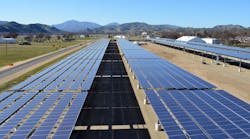The US Army’s recruiting slogan once again is “Be All that You Can Be” after several decades of publicizing other slogans.
The nation’s oldest fighting force might also try to “Be All of the Above” when it comes to its future energy plans for decarbonizing non-combat military operations. In fact, the Army’s Climate Strategy announced last year included a pledge to add a microgrid at every one of its hundreds of installations by 2035.
Military objectives can change as surely as political parties do, but the military clearly is attacking climate change through long-term, lower carbon energy strategies.
What that might look like will vary with the post. A group of military and energy industry experts united earlier this week at the Microgrid Knowledge Conference in Anaheim to highlight the promises and changes of the U.S. Army’s climate pledges.
“Every military installation is different. At Fort Bliss (in Texas) we’re not worried about people freezing, but there might be an issue about heat stroke,” said David Irwin, director of project development at the US Army Office of Energy Initiatives. “At other bases it might be freezing.”
The challenges are formidable and footprints of each individual Army installation present unique problems and opportunities.
“I don’t think there is a least resistant path; there’s just different hurdles,” Irwin said. “We have to determine what those hurdles are going to be.”
Last year, the U.S. Army contracted a privately funded, owned and operated energy resiliency projects with developer Bright Canyon Energy. Construction is underway at Joint Forces Training Base—Los Alamitos to provide a hybrid power project which can sustain the base for at least 14 days in the event of a grid emergency and also provide benefits to the local community around the California base.
The microgrid at Los Alamitos will comprise 26 MW of solar, a 20-MW-40-MWh battery energy storage system of 3 MW of backup generation supplied by Tier 4 diesel gen-sets. The equipment contracts focused on a domestic supply chain, including solar panels by First Solar and Tesla Megapacks for battery storage.
Jason Smith, vice president at Bright Canyon Energy, was part of the Microgrid Knowledge panel and was forthright after the benefits and realities of the developing project. The Los Alamitos base microgrid will be connected to the local grid to create a revenue opportunity, but fully devoted to the critical mission of supplying the base when the energy around it is down.
“This is really an at-the-meter project,” Smith pointed out. “When the grid is up and running, the power goes to San Diego Gas & Electric. . . When the grid goes down, we turn it inward.”
Bright Canyon Energy was fortunate to have a 100-acre footprint at Los Alamitos to do what it needed to build a microgrid at scale, Smith admitted. Not every base situation will offer such ample space.
But the clock is ticking: the US Army has more than 1,000 installations and, if there’s going to be distributed energy resources at every one and fully funded, the work is complex and unrelenting.
The U.S. military is expert at being unrelenting when it comes to defending the nation. Moving through regulatory and complicated energy needs and limitations is another matter.
“We’re good at making things slow,” quipped Irwin, drawing easily the biggest laugh at the Microgrid Knowledge session.
Seriously, though, he noted that the military objectives in energy terms are fairly clear: No. 1 is resiliency; No. 2 is the climate change objective; and No. 3 is cost.
These often conflict and present hurdles, as Irwin admitted. “There’s a lot of tensions between those three,” he said.
Many developers and energy partners are thrilled to have that kind of clarity going forward.
“At least with the military you know resiliency is No. 1,” said Michael Geocaris, consulting engineer with S&C Electric. “Sometimes you never know with other customers” what the top objective is.
Microgrid Knowledge included three days of content and exhibition displays from companies such as S&C, Caterpillar, Enchanted Rock, Block Energy, Siemens, PowerSecure, Scale Microgrid Solutions and numerous others. Next year’s event will be in April at the Harbor in Baltimore.
This story was reposted from EnergyTech, which like Microgrid Knowledge, is a publication of Endeavor Business Media.









